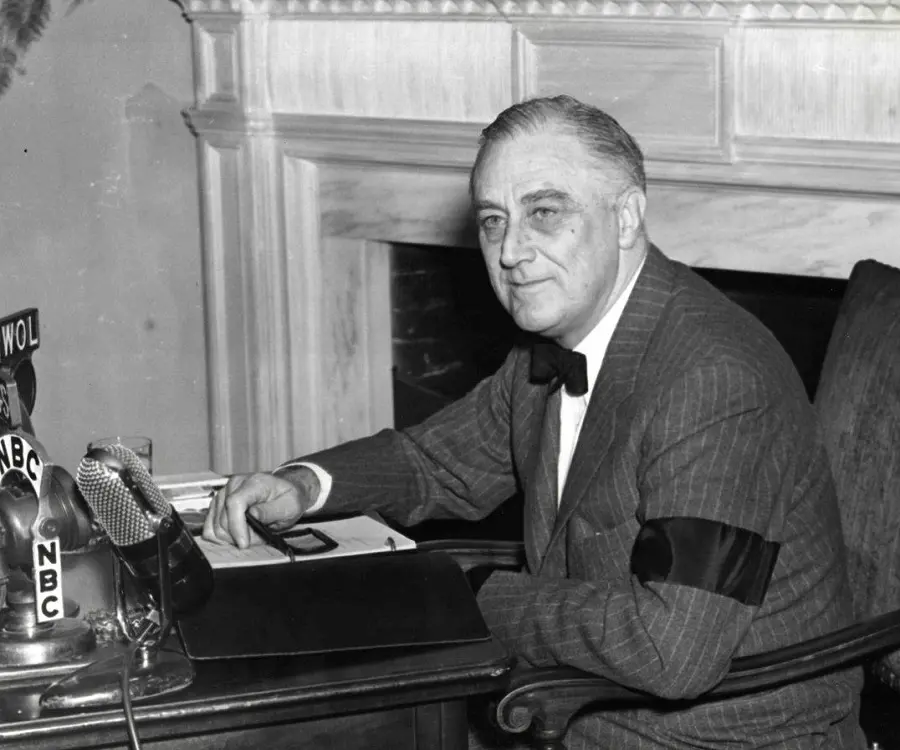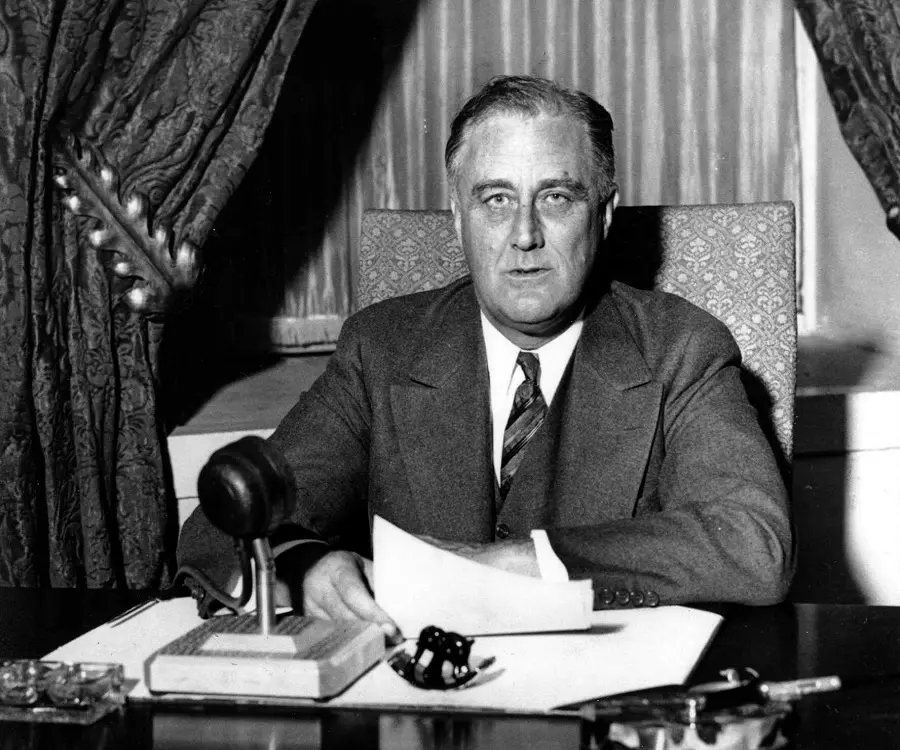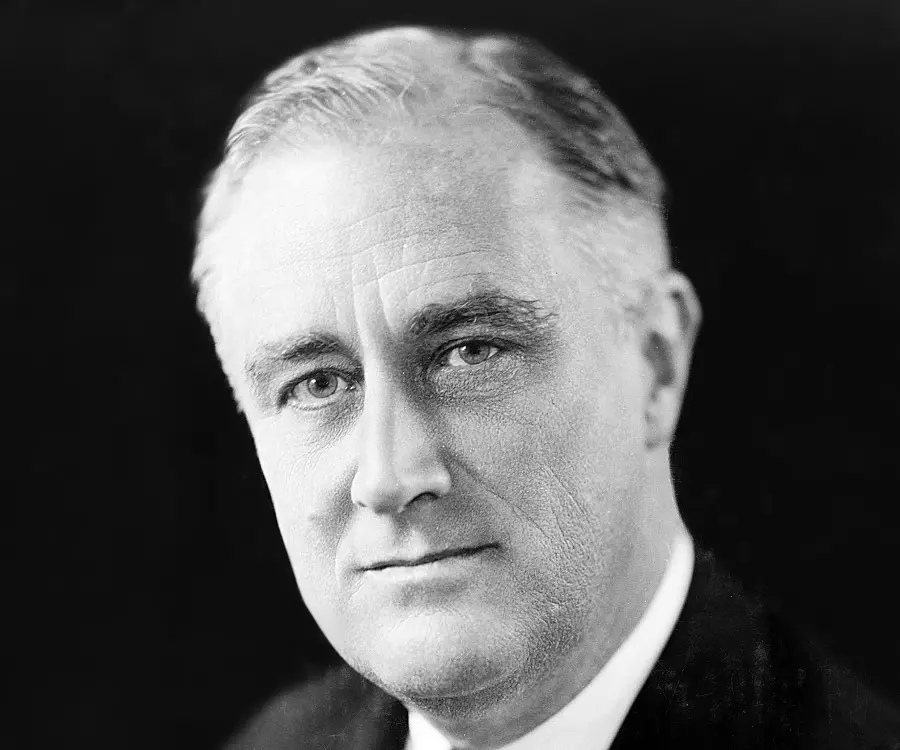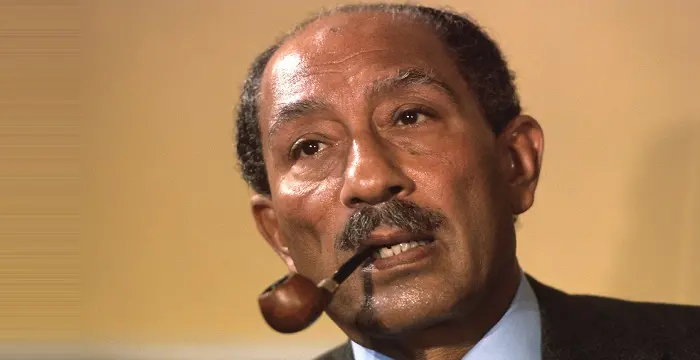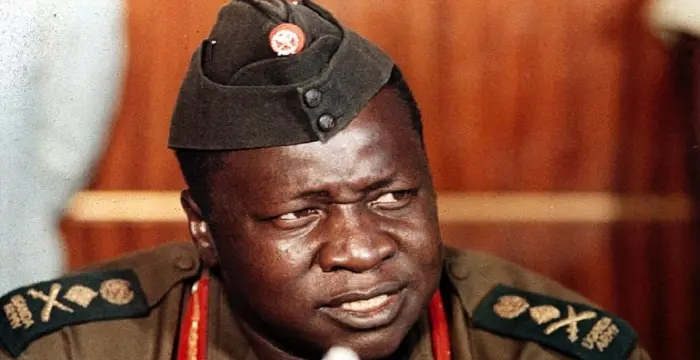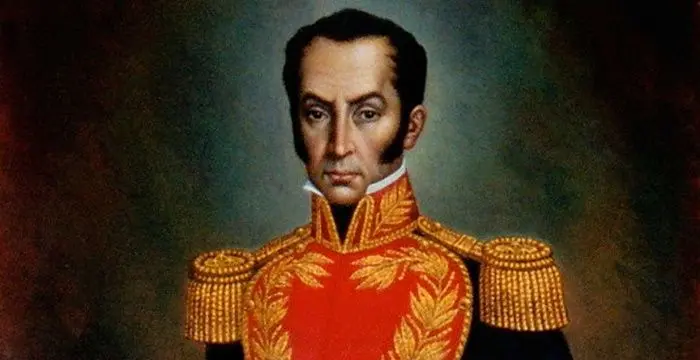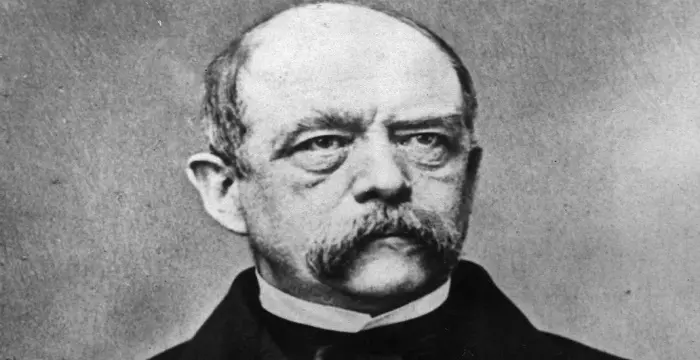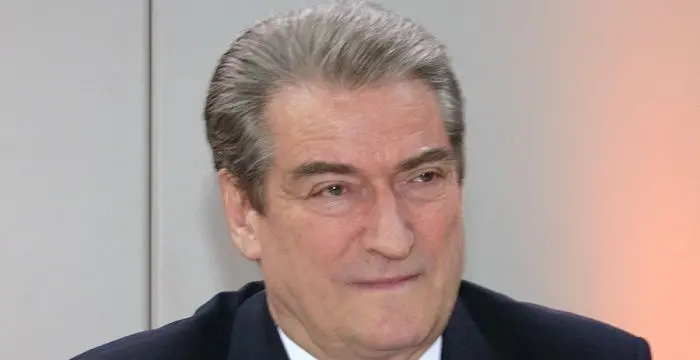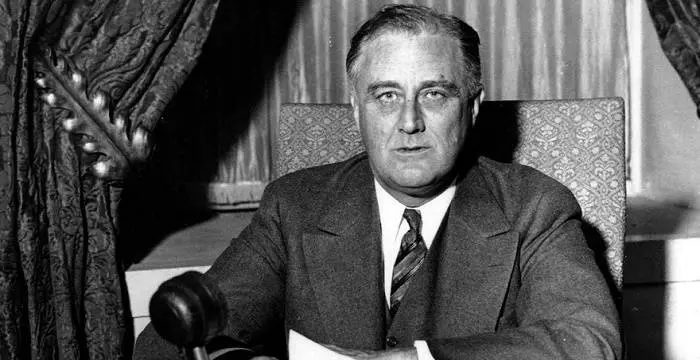
F D Roosevelt - 32nd President of the United States, Timeline and Personal Life
F D Roosevelt's Personal Details
Franklin D
| Information | Detail |
|---|---|
| Birthday | January 30, 1882 |
| Died on | April 12, 1945 |
| Nationality | American |
| Famous | Leaders, Political Leaders, Presidents, 32nd President of the United States |
| Spouses | Eleanor |
| Childrens | James Roosevelt |
| Universities |
|
| Birth Place | Hyde Park |
| Political Ideology | Democratic |
| Religion | Episcopal |
| Gender | Male |
| Father | James Roosevelt |
| Mother | Sara Ann Delano |
| Sun Sign | Aquarius |
| Born in | Hyde Park |
| Famous as | 32nd President of the United States |
| Died at Age | 63 |
F D Roosevelt's photo
Who is F D Roosevelt?
Jean Edward Smith’s quote ‘He lifted himself from a wheelchair to lift the nation from its knees’ best describes Roosevelt’s prominent position in the United States political scenario. The 32nd President of United States, Franklin Delano Roosevelt remained the key figure during the mid of the 20th century. A man with a vision, he led United States in its worst time of crises and helped the country come out of the realms of Great Depression to become an economically powerful country in the world with restored prosperity. It was his optimistic approach and never-say-die attitude that instilled in the people a nationalistic spirit. During the World War II, he successfully retained the neutral stand of United States despite making the country an ‘Arsenal of Democracy’ and aiding China and Great Britain all through during the war. Roosevelt is the only US President to be elected four times consecutively. In his twelve years long service as the President of the United States, Roosevelt dominated America’s political scene completely, so much so that even decades after, his dominance was virtually present and greatly felt. He was the primary founder and the initiator for the formation of later formed United Nations and Bretton Woods. Along with Abraham Lincoln and George Washington, Franklin Roosevelt is one of the top three U.S. Presidents.
// Famous Political Leaders
Edi Rama
Edi Rama is the current Prime Minister of Albania. Check out this biography to know about his childhood, life, achievements, works & timeline.
Khalifa bin Zayed Al Nahyan
Sheikh Khalifa bin Zayed Al Nahyan is the current President of the United Arab Emirates (UAE). Check out this biography to know about his birthday, childhood, family life, achievements and fun facts about him.
Leo Varadkar
Cam Leo Varadkar is the current Taoiseach—the Prime Minister—of the Republic of Ireland. Check out this biography to know about his childhood, family life, achievements and other facts about his life.
Childhood & Early Life
Born to James Roosevelt and Sara Ann Delano, Franklin Delano Roosevelt was the only child of the couple. Coming from a wealthy family of English descent, young Roosevelt was raised in an atmosphere of privilege.
Academically, Roosevelt was an average student. He attained his preliminary education from Groton School, after which he enrolled at Harvard College graduating from the same in 1903 with an A.B. in history.
In 1904, Roosevelt entered Columbia Law School but dropped out of the same as he had cracked the New York Bar exam. His first employment was at the Wall Street firm of Carter Ledyard & Milburn, dealing mainly with corporate law.
Entry into Politics
Roosevelt’s entry into politics was during the New York State Senate elections of 1910. Though he had no prior experience in the same, the fact that he was a Roosevelt and had a lot of wealth, prestige and influence at the Hudson Valley to fall back on was enough to guide him through.
Opposing the Tammany bossism, Roosevelt was in support of the state Democratic party. He successfully upset the Tammany machine by blocking their selected candidate over James A. O'Gorman.
The entire episode brought Roosevelt national exposure and gave him a first-hand experience in tactics and scheming that prevail in the world of politics. Though he had become popular with the people, he had not developed on eloquent speaking.
Serving as the chairman of the Agricultural Committee, Roosevelt brought in new reforms that supported laboUr and social welfare programs for women and children.
Political Pursuits
In the 1912 presidential elections, Roosevelt supported Woodrow Wilson's candidature. Wilson’s appointment as the President opened new doors of opportunity for Roosevelt as he found a place for himself in the Wilson administration. Resigning from his post in the New York State Senate, Roosevelt took up the position of Assistant U.S. Secretary of the Navy in 1913.
His terms at the Navy lasted for seven years. During his service, Roosevelt was passionately involved with the intricacies of the work and supported Josephus Daniels (Secretary of the Navy) completely for building a large and efficient naval force. He worked to expand the Navy, secured approval in the financial budget and looked into the smooth functioning.
Roosevelt was not comfortable acting as a second fiddle and thus decided to run for the US Senate seat of New York. However, the proposition was doomed from the start as he did not gain White House support. Nevertheless, he contested in it and was convincingly beaten. Though the results came out unfavourably, the election made Roosevelt realize that support of the White House was invincible.
Resigning from his post at the Navy, Roosevelt stood as a candidate for the Vice Presidential elections in 1920. However, he was beaten by the Republic candidate, Warren G. Harding by a wide margin. Post the defeat, he returned to New York and started practicing law.
Tragedy struck Roosevelt in 1921 when he contracted polio, which caused permanent paralysis of his lower body starting from the waist. While some believed that this was the end of this political journey, Roosevelt showed great courage and determination and fought the disease to retain his political career.
Roosevelt spent the early 1920s mending his relationships with the Democratic Party. He supported Alfred E Smith for the chair of the Governor of New York in 1922 and 1924.
In 1928, he replaced Smith as the contender for the seat of the Governor of New York, which he won narrowly. He worked as a reform governor and established a number of social programs for the betterment of the society by large. He retained the post of the Governor for the second term as well in 1930.
For the 1932 Presidential elections, Roosevelt was an obvious choice from the Democratic Party, given his strong base and support in New York. The campaign which was conducted under the shadow of Great Depression gave Democrats an upper hand from the Republicans, who were blamed for the Depression.
Roosevelt ran his presidency ticket calling for a government intervention in the economy to provide relief, reform and recovery to its people. He advocated for reduction in the public expenditure, dismantling of useless commissions, organization of departments and curtailing extravagances.
It was his buoyant spirit, optimistic outlook and charming mannerism that helped Roosevelt win over Republican candidate, Herbert Hoover, with a 57% votes in all except six states.
First Term of Presidency 1933
When Roosevelt took to office on March 4, 1933, America was undergoing its greatest period of crisis. Rate of unemployment had reached its peak, farmers experienced a tragic dip as prices fell by 60%, industrial production was rock low and hundred of banks faced temporary closure.
Standing true to his campaigning program, Roosevelt looked to provide relief, recovery and reform to his people. Relief was putting the large number of unemployed force back in action, recovery was making the economy return to normal and reform involved fixing for good the financial and banking systems of the country.
Jumping straight into action, Roosevelt proposed new economic reforms, which he called ‘New Deal’. According to it, he, along with his advisors, supervised the formation of different agencies.
The agencies were entrusted with a specific goal. While Agricultural Adjustment Administration looked after supporting farm prices, Civilian Conservation Corps employed young men. National Recovery Administration was in charge of regulating the wages and prices. Other agencies insured bank deposits, regulated the stock market, subsidized mortgages, and provided relief to the unemployed.
Working along with Republican Senator George Norris, he created the largest government-owned industrial enterprise in American history, the Tennessee Valley Authority which built dams and power stations, controlled floods, and modernized agriculture and home conditions in the poverty-stricken Tennessee Valley
Roosevelt brought about a Second New Deal in 1934, which led to the formation of Works Progress Administration that set up a national relief agency, employing about two million people. It brought the rate of unemployment down by almost 8 per cent.
Though the First New Deal was jointly supported by people of all classes, the Second New Deal challenged the business class and hence failed to gain their support.
Though the economy showed signs of improvement under the Roosevelt presidency, he faced criticism for his numerous New Deal projects, so much so that some of them were declared unconstitutional. Additionally, increased government spending and unbalanced budgets were major causes of worry in his Presidency.
In 1936 Presidential election, Roosevelt managed to attain maximum votes as he was backed by a coalition of voters which included traditional Democrats, small farmers, Catholics, big city political machines, labour unions, northern African Americans, Jews, intellectuals and political liberals.
Second Term 1937
Much in contrast with the reforming first term, Roosevelt’s second term witnessed less major legislative reforms being passed. Some of them included the Housing Act of 1937, a second Agricultural Adjustment Act and the Fair Labor Standards Act (FLSA) of 1938.
The Supreme Court casted a stern eye on Roosevelt’s suggested reforms and overturned many of them. Furious by this, Roosevelt proposed a new law which allowed him to appoint judges as well. However, this proposal was deeply doomed as everyone, including Democrat, voted against it, as it gave the President control over the Court as well.
Negative publicity, a continuing sluggish economy, and Republican victories in mid-term elections virtually ended Roosevelt's ability to pass more reform legislation. The labour unions which backed him were also split up, thus weakening the party elections from 1938 until 1946.
Meanwhile, Adolf Hitler’s rise to power sent wave of fear all through, of a new World War. Nevertheless, the Neutrality Acts passed in 1930s helped United States from being entangled in foreign conflicts. Also, after the World War I, United States had adopted an isolationist policy in foreign affairs.
In 1939, drifting away from the neutrality policy, Roosevelt sought ways for supporting the Britain and France military. With the fall of countries in the Western Europe, Roosevelt capitalized on the changing sentiments of isolation and enhanced the military spending
As military conflicts emerged in Asia and Europe, Roosevelt openly defied the neutrality act and found ways of helping China win over Japan in its war. He also declared France and Great Britain as America’s ‘first line of defense’ against Nazi Germany. America started providing military supplies to China, Britain and Soviet Union.
Though Roosevelt had not publicly announced his third consecutive and unprecedented run as the President, he secretly desired the same as he felt that none other than him had the experience to lead America in the trying times that the world faced.
He upheld his candidature with tactics and skills and soon moved past all challengers at the Democratic National Convention in Chicago to be proclaimed as the Democratic candidate.
Campaigning against Republican candidate Wendell Willkie, Roosevelt claimed to take all the effort required to keep United States out of war. He won the 1940 elections with a magnanimous 55% votes in all but 10 states. Henry A. Wallace was appointed as the Vice President
Third Term 1941
Much of Roosevelt’s third term as a President was dominated by the Second World War. United States had become an ‘arsenal of democracy’ for Allies like Britain, France and Russia.
The isolation sentiments too had weakened, though he did face some resistance from Senators William Borah and Robert Taft. Taking advantage of the position, Roosevelt increased the support to the Allies against Germany, Japan and Italy by providing them with greater supplies.
Though he was tagged as a warmonger, he did not care much about the criticism and instead focussed to continue his twin policies of preparedness and aid to the Allied coalition. He was confident of his foreign policy initiatives.
In 1941, he formulated a program along with Churchill, which gave a detailed account of the necessary amount of manpower, mobilization, industry and logistics required to defeat the ‘potential’ enemy of United States
United States active non-participation in the World War II ended when the Japanese attacked the Pearl Harbor on December 7, 1941. Though all American officials knew that the war was impending, none of them had anticipated the attack on Pearl Harbor. With more than 16 warships and battleships damaged and 3000 American military personnel and civilians killed, US’s involvement was obvious.
With Germany’s and Italy’s declaration of war on US, Roosevelt, along with his military advisors, formed a war strategy with a couple of objectives. The first was to put an end to the German advances in the Soviet Union and in North Africa, to launch an invasion of western Europe with the aim of crushing Nazi Germany between two fronts; to save China and defeat Japan.
With public sentiments high on defeating Japan, American forces were sent to the Pacific in 1942. The US Navy scored a decisive victory over the Battle of Midway. They then began the process of island hopping. This was with the aim of gaining bases from which strategic airpower could be used to finally invade Japan.
Meanwhile, Roosevelt developed a strategy for defeating Germany in Europe through a series of invasions, first in North Africa in November 1942, then Sicily and Italy in 1943, followed by the D-Day invasion of Europe in 1944.
By 1943, when it was obvious that the Allies would finally defeat the Nazi Germany, Roosevelt arranged a meeting with Churchill and Chinese leader Chiang Kai-shek, on postwar future of Europe. It was during this meeting that he initiated the proposal of formation of United Nations.
Fourth Term & Final Years
Declining health had put a toll on Roosevelt, who was found to be suffering from multiple issues like high blood pressure, atherosclerosis, coronary artery disease causing angina pectoris, and congestive heart failure.
Roosevelt chose Harry S Truman as his Vice Presidential Candidate for 1944 elections. Together they won with 53% votes and carried 36 stated. Thus Roosevelt got elected for a record fourth term
In the last few days, Roosevelt travelled to Egypt to attend the Yalta Conference, where he met Haile Selassie, Emperor of Ethiopia. Two days later, he met Saudi Arabia founder King Abdulaziz. Upon returning from the Yalta Conference, Roosevelt briefed the Congress about the proceedings. This was his last outing as his illness got the better of him
Personal Life & Legacy
Roosevelt was formally introduced to his future wife Eleanor Roosevelt, in 1902 on a train to Tivoli, New York. The two had built on a good rapport and understanding and soon walked the aisle in 1905.
The couple was blessed with six children, Anna Eleanor, James, Franklin Delano, Jr., Elliott, Franklin Delano, Jr. and John Aspinwall
He was reported to have a number of romantic relationships outside marriage; the most prominent of them was with Eleanor’s secretary, Lucy Mercer. Other’s whom he was romantically linked to were Marguerite "Missy" LeHand and Princess Martha of Sweden.
Roosevelt’s adulterated behaviour resulted in Eleanor’s separate living. The marriage turned out to be more of a political partnership than an intimate relationship.
Roosevelt passed away on April 12, 1945, after suffering from massive cerebral haemorrhage. The following day, his body was placed in a flag-draped coffin and loaded onto the presidential train. Post the White House funeral, Roosevelt’s body was carried back to Hyde Park, and was buried in the Rose Garden of the Springwood estate.
Washington houses two memorials as a way to pay tribute to the former president. There are several parks, schools, aircraft carrier, streets and squares across US that have been named after him. The airport at the Dutch Caribbean island of St. Eustatius is named after him.
He was commemorated by the United States Postal Service with a Prominent Americans series 6 postage stamp, issue of 1966. Additionally, he appears on several other U.S. Postage stamps.
Trivia
He was the 32nd President of United States and was popularly known as FDR.
He was the only US President to be elected four times. He died after he was elected the fourth time.
Despite being diagnosed with polio, which resulted in permanent paralysis of his body waist down, he did not succumb down and instead fought his disease bravely. Instead, he worked his way to become the President of United States and held the position for three terms.
During his Presidency, he guided United States through the Great Depression and World War II.
// Famous Leaders
Edi Rama
Edi Rama is the current Prime Minister of Albania. Check out this biography to know about his childhood, life, achievements, works & timeline.
Tecumseh
Tecumseh was a Native American leader of the Shawnee clan. This biography profiles his childhood, life and timeline.
Khalifa bin Zayed Al Nahyan
Sheikh Khalifa bin Zayed Al Nahyan is the current President of the United Arab Emirates (UAE). Check out this biography to know about his birthday, childhood, family life, achievements and fun facts about him.
F D Roosevelt biography timelines
- // 30th Jan 1882Born to James Roosevelt and Sara Ann Delano, Franklin Delano Roosevelt was the only child of the couple. Coming from a wealthy family of English descent, young Roosevelt was raised in an atmosphere of privilege.
- // 1903Academically, Roosevelt was an average student. He attained his preliminary education from Groton School, after which he enrolled at Harvard College graduating from the same in 1903 with an A.B. in history.
- // 1904In 1904, Roosevelt entered Columbia Law School but dropped out of the same as he had cracked the New York Bar exam. His first employment was at the Wall Street firm of Carter Ledyard & Milburn, dealing mainly with corporate law.
- // 1905Roosevelt was formally introduced to his future wife Eleanor Roosevelt, in 1902 on a train to Tivoli, New York. The two had built on a good rapport and understanding and soon walked the aisle in 1905.
- // 1910Roosevelt’s entry into politics was during the New York State Senate elections of 1910. Though he had no prior experience in the same, the fact that he was a Roosevelt and had a lot of wealth, prestige and influence at the Hudson Valley to fall back on was enough to guide him through.
- // 1912In the 1912 presidential elections, Roosevelt supported Woodrow Wilson's candidature. Wilson’s appointment as the President opened new doors of opportunity for Roosevelt as he found a place for himself in the Wilson administration. Resigning from his post in the New York State Senate, Roosevelt took up the position of Assistant U.S. Secretary of the Navy in 1913.
- // 1920Resigning from his post at the Navy, Roosevelt stood as a candidate for the Vice Presidential elections in 1920. However, he was beaten by the Republic candidate, Warren G. Harding by a wide margin. Post the defeat, he returned to New York and started practicing law.
- // 1921Tragedy struck Roosevelt in 1921 when he contracted polio, which caused permanent paralysis of his lower body starting from the waist. While some believed that this was the end of this political journey, Roosevelt showed great courage and determination and fought the disease to retain his political career.
- // 1928In 1928, he replaced Smith as the contender for the seat of the Governor of New York, which he won narrowly. He worked as a reform governor and established a number of social programs for the betterment of the society by large. He retained the post of the Governor for the second term as well in 1930.
- // 1932For the 1932 Presidential elections, Roosevelt was an obvious choice from the Democratic Party, given his strong base and support in New York. The campaign which was conducted under the shadow of Great Depression gave Democrats an upper hand from the Republicans, who were blamed for the Depression.
- // 1933When Roosevelt took to office on March 4, 1933, America was undergoing its greatest period of crisis. Rate of unemployment had reached its peak, farmers experienced a tragic dip as prices fell by 60%, industrial production was rock low and hundred of banks faced temporary closure.
- // 1934Roosevelt brought about a Second New Deal in 1934, which led to the formation of Works Progress Administration that set up a national relief agency, employing about two million people. It brought the rate of unemployment down by almost 8 per cent.
- // 1936In 1936 Presidential election, Roosevelt managed to attain maximum votes as he was backed by a coalition of voters which included traditional Democrats, small farmers, Catholics, big city political machines, labour unions, northern African Americans, Jews, intellectuals and political liberals.
- // 1937Much in contrast with the reforming first term, Roosevelt’s second term witnessed less major legislative reforms being passed. Some of them included the Housing Act of 1937, a second Agricultural Adjustment Act and the Fair Labor Standards Act (FLSA) of 1938.
- // 1939In 1939, drifting away from the neutrality policy, Roosevelt sought ways for supporting the Britain and France military. With the fall of countries in the Western Europe, Roosevelt capitalized on the changing sentiments of isolation and enhanced the military spending
- // 1940Campaigning against Republican candidate Wendell Willkie, Roosevelt claimed to take all the effort required to keep United States out of war. He won the 1940 elections with a magnanimous 55% votes in all but 10 states. Henry A. Wallace was appointed as the Vice President
- // 1941In 1941, he formulated a program along with Churchill, which gave a detailed account of the necessary amount of manpower, mobilization, industry and logistics required to defeat the ‘potential’ enemy of United States
- // 7th Dec 1941United States active non-participation in the World War II ended when the Japanese attacked the Pearl Harbor on December 7, 1941. Though all American officials knew that the war was impending, none of them had anticipated the attack on Pearl Harbor. With more than 16 warships and battleships damaged and 3000 American military personnel and civilians killed, US’s involvement was obvious.
- // 1942With public sentiments high on defeating Japan, American forces were sent to the Pacific in 1942. The US Navy scored a decisive victory over the Battle of Midway. They then began the process of island hopping. This was with the aim of gaining bases from which strategic airpower could be used to finally invade Japan.
- // 1942 To 1944Meanwhile, Roosevelt developed a strategy for defeating Germany in Europe through a series of invasions, first in North Africa in November 1942, then Sicily and Italy in 1943, followed by the D-Day invasion of Europe in 1944.
- // 1943By 1943, when it was obvious that the Allies would finally defeat the Nazi Germany, Roosevelt arranged a meeting with Churchill and Chinese leader Chiang Kai-shek, on postwar future of Europe. It was during this meeting that he initiated the proposal of formation of United Nations.
- // 1944Roosevelt chose Harry S Truman as his Vice Presidential Candidate for 1944 elections. Together they won with 53% votes and carried 36 stated. Thus Roosevelt got elected for a record fourth term
- // 12th Apr 1945Roosevelt passed away on April 12, 1945, after suffering from massive cerebral haemorrhage. The following day, his body was placed in a flag-draped coffin and loaded onto the presidential train. Post the White House funeral, Roosevelt’s body was carried back to Hyde Park, and was buried in the Rose Garden of the Springwood estate.
// Famous Presidents
Khalifa bin Zayed Al Nahyan
Sheikh Khalifa bin Zayed Al Nahyan is the current President of the United Arab Emirates (UAE). Check out this biography to know about his birthday, childhood, family life, achievements and fun facts about him.
Anwar Sadat
Anwar Sadat was the third President of Egypt and has been awarded the Nobel Prize for his peace initiatives. To know more about his childhood, career, profile and timeline read on the following biography.
Idi Amin
A Ugandan dictator, Idi Amin is remembered for his brutal regime and crime against humanity. Check this biography to know in details about his life, childhood, profile and timeline.
Simon Bolivar
Simón Bolívar was a Venezuelan military leader who was instrumental in independence of several Latin American countries from the Spanish rule. This biography profiles his childhood, life, achievements and timeline.
Otto von Bismarck
Otto von Bismarck served as the Chancellor of Germany and the Prime Minister of Prussia. He unified the German states into a powerful German empire. This biography profiles his childhood, political career, life, achievements and timeline.
Sali Berisha
Sali Berisha is an Albanian politician who served as the President and the Prime Minister of Albania. Check out this biography to know about his childhood, life, achievements, works & timeline.
F D Roosevelt's FAQ
What is F D Roosevelt birthday?
F D Roosevelt was born at 1882-01-30
When was F D Roosevelt died?
F D Roosevelt was died at 1945-04-12
Where was F D Roosevelt died?
F D Roosevelt was died in Warm Springs
Which age was F D Roosevelt died?
F D Roosevelt was died at age 63
Where is F D Roosevelt's birth place?
F D Roosevelt was born in Hyde Park
What is F D Roosevelt nationalities?
F D Roosevelt's nationalities is American
Who is F D Roosevelt spouses?
F D Roosevelt's spouses is Eleanor
Who is F D Roosevelt childrens?
F D Roosevelt's childrens is James Roosevelt
What was F D Roosevelt universities?
F D Roosevelt studied at Groton School, Harvard College, Columbia Law School
What is F D Roosevelt's political ideology?
F D Roosevelt's political ideology is Democratic
What is F D Roosevelt's religion?
F D Roosevelt's religion is Episcopal
Who is F D Roosevelt's father?
F D Roosevelt's father is James Roosevelt
Who is F D Roosevelt's mother?
F D Roosevelt's mother is Sara Ann Delano
What is F D Roosevelt's sun sign?
F D Roosevelt is Aquarius
How famous is F D Roosevelt?
F D Roosevelt is famouse as 32nd President of the United States
